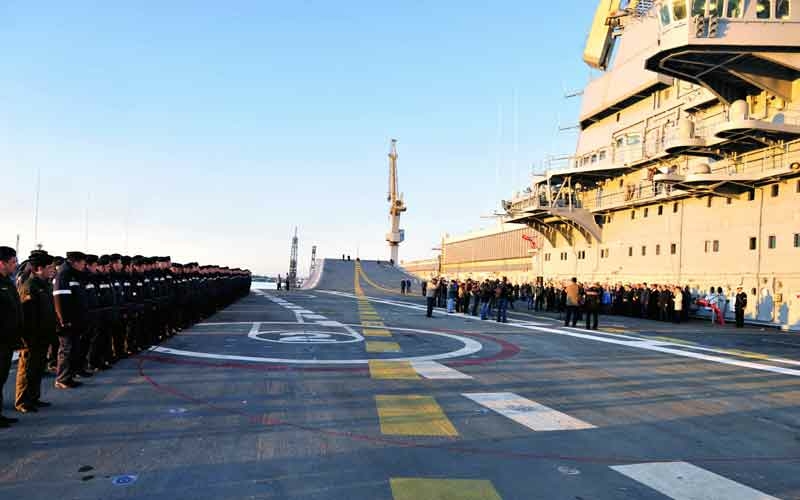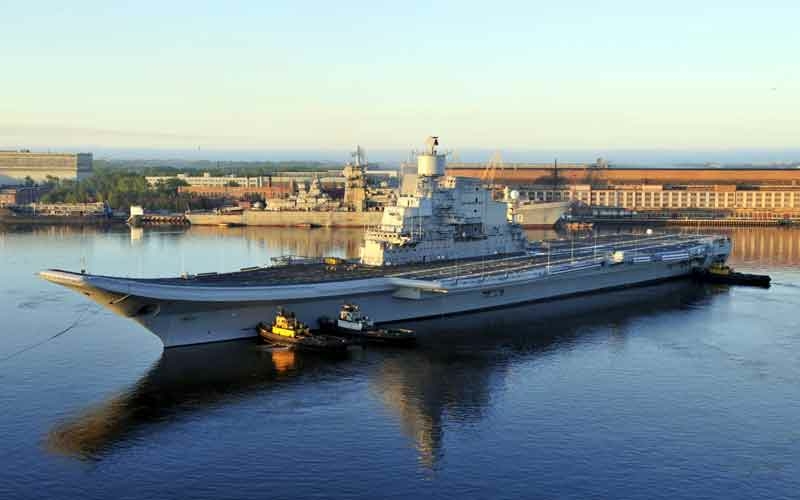Posted July 26, 2012 by admin in China Military News.
The INS Vikramaditya aircraft carrier (former Admiral Gorshkov), which Russia refurbished for India, left its berth at the Sevmash shipyard in Russia’s northern city of Severodvinsk and sailed into the White Sea to undergo trials on June 8.
Russian and Indian crews will board the carrier for the sea trials, however Indian sailors will only act as observers.
India has spent billions of US dollars upgrading the carrier Vikramaditya without improving its own shipbuilding abilities.
The Vikramaditya is a modified Kiev-class aircraft carrier which was formally called the “Admiral Gorshkov”. The Admiral Gorshkov entered service in 1987 and was sent for repairs in February 1992. However, due mainly to a funding crisis, the Russian navy decided to withdraw it from service.
At the same time, the Indian navy was considering buying a large out-of-service carrier.
Subsequently, in 2004, Russia and India signed a deal for the refurbishment of the Admiral Gorshkov. The carrier itself was free, however India had to get it refitted at the Sevmash shipyard at a cost of US$750 million and buy Russian-made MiG-29K fighters as its carrier drones. The delivery time was originally set for 2008, but due principally to underestimated workload and the shipyard’s lack of experience in building and refurbishing aircraft carrier, the delivery time was continually postponed, with costs jumping to more than US$2.3 billion.
According to the requirements of the Indian navy, Russia completely refitted the Admiral Gorshkov. The improvement involved stripping all of the armaments and radar from the foredeck and greatly enlarging the surface of the flight deck. The foredeck was also turned into a ski-jump.
The refitted Vikramaditya will be better equipped than India’s current serving carrier. MiG-29K fighters are superior to the old British Sea Harrier fighters, and the carrier’s comprehensive fighting force can compare with that of the nuclear-powered French aircraft carrier, the Charles de Gaulle.
China purchased the unfinished aircraft carrier Varyag from Ukraine at a price of US$20 million… By doing so, China spent less money…
India is currently engaging in building up its naval force. It is now in the process of constructing an Air Defense Ship, which is actually an aircraft carrier, as well as three missile-guided destroyers, and three invisible missile frigates. In addition, it has ordered a number of missile frigates from Russia. If all these plans are carried out successfully, India will not only consolidate its dominant position in the Indian Ocean, it will also have one of the world’s top five most powerful navies.
The former Soviet Union had the world’s second largest navy during the Cold War. However, since the crumbling of the USSR, the Russian navy has been forced to decommission many of its ships due to a lack of funds and broken industrial chain. Russia’s naval power cannot really compare with that of the former USSR during the Cold War. Economic woes have prevented Russia from undertaking large-scale shipbuilding to replace those decommissioned ships.
Not far from the North Shipyard where the carrier Vikramaditya is being refitted, Russia is building a new generation of naval vessel called the Admiral Gorshkov, which is the former name of Vikramaditya.
Ironically, the “Admiral Gorshkov”, once used as the name of a 40,000 ton carrier, is now a large frigate with a displacement of only 5,000 tons. The new “Admiral Gorshkov” is a symbol of the state of the Russian navy: It has ambitions to restore its former glory, but lacks the ability to put such ambitions into practice.
Russia discarded its plan to repair the large Kirov-class battle cruiser, and instead built a batch of 2,000-ton light frigates and 5,000-ton medium-sized surface ships in order to strengthen its coastal defenses.
But it could not even implement this downscaled plan. The Russian navy has to use 600-ton large missile boats and tiny frigates in order to keep up appearances during its annual large-scale military drill.
We can predict that Russia will be unable to strengthen its naval force in the short term. Most of its ships will go out of service in 10 years, and without new ships to take their place, the Russian navy will inevitably become a near-sea fleet.
While the Russian navy is in decline, both China and India have built up their navies after learning from Russia’s heritage and buying large surface ships from Russia and building their naval fleets around those carriers.
However, India and China’s paths have been different. After purchasing the Gorshkov from Russia, India chose to get it repaired in Russia because it lacked the capacity and technology to undertake such a difficult project.
India will not only consolidate its dominant position in the Indian Ocean, it will also have one of the world’s top five most powerful navies.
India has spent billions of US dollars upgrading the carrier Vikramaditya without improving its own shipbuilding abilities. Instead the upgrade improved the shipbuilding capabilities of the Russian shipyard. No wonder Russia plans to send its own carrier to the shipyard for upgrading after the upgrade of the Vikramaditya is completed.
China purchased the unfinished aircraft carrier Varyag from Ukraine at a price of US$20 million. Depending solely on its own industry and advanced ship building craft, China repaired and made improvements to the carrier. By doing so, China spent less money, accumulated experience in aircraft carrier remodeling and learned valuable lessons which will help it to construct its own carrier.
More importantly, China and India are not at the same industrial level. Over the past ten years, the Chinese navy has built 16 large missile frigates and at least 10 guided-missile destroyers, as well as advanced submarines. Most of the weapons have been designed and made by China. India has started to build 6 destroyers and 6 frigates over the past 10 years, but currently only one frigate has been put into service. And it seems that the Indian navy will rely on overseas purchases in order to maintain its fleet in the future.







Dont worry. India’s Protectionism/Reservation in all fields is the most potent/Lethal Weapon that can be compared to Weapon of mass Destruction and will be used against any Enemies.This is why Indians had completed only 1 against 16+10 of nearby neighbour.Here in India those who remains are half baked , Loaded up to 100% , and good brains are flown away.( If they remain in India , then also they feels that they are treated as second class citizen of India, by experiencing less chances of getting admission to professional colleges, less recruitment, Less promotion, being they are born in Non Neo elite cast
India’s indegenous Aircraft-Carrier at Kochi South India completed more than 50% !!